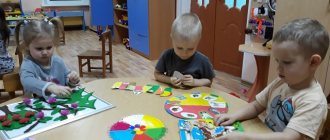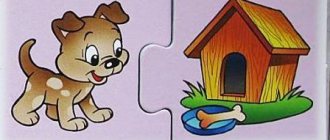The purpose of the didactic game “Dangerous Objects”
The goal is to form and consolidate knowledge about what objects are potentially dangerous to humans and how to handle them.
Tasks:
- identification of dangerous household items, identifying them in the environment;
- acquiring the skill of using them safely;
- developing an understanding of dangerous situations, ways to prevent them, rules of conduct in case of an emergency;
- consolidation of the concepts of “danger”, “safety”, “caution”;
- development of intelligence, visual perception, reaction speed, ability to think logically, and argue one’s opinion;
- fostering responsibility and independence.
COMPETENTLY
Valery Aristov, President of the Foundation for the Development of Intellectual Abilities, "Galaktika" President of the Association of Intellectual Games, researcher at the Institute of Pedagogy of the Academy of Pedagogical Sciences of Ukraine, director of the author's school, academician of the European Academy of Natural Sciences and the International Academy of Original Ideas:
“The one who looks at chess or checkers only as recreation and entertainment is mistaken. On the contrary, games should be perceived as a psychological model for the development of human intellectual abilities. And above all, as the development of attention, which is always at the epicenter of mental activity. Intellectual play creates cognitive therapy - managing emotions, developing imagination - the main component of creative thinking. In the gameplay model, in conditions of hidden delight or panic, the player involuntarily learns to manage his emotions. It is especially important that the player’s strong-willed qualities are cultivated at the table, his tolerance is formed, and processes are thought through that will later be useful in life situations. This is a planned formation of experience, or as it is now called – training.
In the process of playing, a personality is formed that learns to take risks and always, in constantly changing situations, strives to play its game without yielding to the enemy. Each time, overcoming psychological discomfort from the destructive influence of internal “brakes” - uncertainty, doubt, feelings of danger and fear - the player cultivates self-respect and pride. At the same time, the ability to doubt the obvious and, disregarding authorities in a particular field of activity, to look for alternative ways to solve a problem is cultivated. And what is especially important is that a culture of player behavior is fostered.
The good thing about an intellectual game is that most players, without even thinking about the consequences, develop not only memory, sustained attention, attentiveness, observation, imaginative, logical, creative and philosophical thinking, speed of thinking, thinking on , the ability to think for a partner, as well as patience, confidence, endurance (during psychological pressure, loss or win), perseverance, tolerance and other volitional and personal qualities. They help you communicate! Intellectual sports are needed no less, and maybe more, than physical ones. The development of the nation’s intellect and the well-being of the country depend on this.”
Junior group
We offer games on the theme “Dangerous Objects” for younger preschoolers.
Dangerous household items
The game is a lotto. For it you need to prepare a table with cells depicting dangerous things, as well as corresponding cards.
The teacher reads a poem or riddle about the subject. The students, having guessed what this thing is, choose a card and cover the picture in the table cell with it.
Green or red
For this lesson you need to prepare two large circles: green and red. It is also necessary to cut out small circles depicting dangerous and safe things.
The teacher lays out the pictures in front of the players. They carefully examine the images, discuss the purpose and degree of danger of the drawn objects. Then they arrange the pictures around large circles, like petals around the core of a flower. Objects that are dangerous are placed in the red circle, and items that are completely safe to use are placed in the green circle.
Dangers
The game reinforces the idea of what dangers a preschooler can face in everyday life, how to deal with them, and how to act correctly. The activity also teaches empathy and fosters a desire to help people in trouble. It is necessary to prepare plot pictures depicting various dangerous situations that can happen to a preschooler at home, in the yard, or in nature.
The teacher places the pictures face down. Pupils take turns taking a card at random, look at the depicted plot, tell what they see, why such a situation happened to the child, what he did wrong, how to correct the mistake, how to act.
Card index of didactic games on life safety/healthy lifestyle
Material and equipment:
Doll Masha, clothes for her.
Progress:
The teacher shows the doll Masha, incorrectly dressed for a walk (the coat is not buttoned, there is no scarf or mittens, etc.), clarifies whether Masha is dressed correctly for the walk, why not, and offers to tell and show Masha how to dress. At the teacher’s suggestion, children put on clothes, show and tell why a scarf, mittens, etc. are needed.
Age group:
first junior
Card No. 13
Type: didactic game on life safety
Title: “We have order”
Target:
To form in children the knowledge that for convenience and safety, all objects need to be put back in place; strengthen the understanding of the rules of safe behavior at home; cultivate a desire to maintain cleanliness and order in the house.
Material and equipment:
Pictures depicting items of clothing, shoes, dishes, sewing accessories, work tools, pictures depicting a kitchen cabinet, wardrobe, work drawer.
Progress:
The teacher reminds children how important it is to put things back in place so that they are easy to find, and it is especially important to properly store dangerous objects - put objects in their places - and offers to arrange object pictures with images of their destinations.
Age group: first junior
Card No. 14
Type: didactic game on healthy lifestyle
Title: “Show it on yourself”
Target:
Give children basic ideas about themselves as a person; introduce the external structure of the body and its capabilities.
Material and equipment:
Doll.
Progress:
The teacher brings a doll into the group:
—The doll Katya came to visit us and wants to tell and show us something. Here's Katya's head. Do you have a head?
Children show parts of the head and face as explained by the teacher.
—What does the doll have on its head?
(
Hair, ears
)
—This face. Cover your face with your hands, open it.
—What do Katya and you have on your face?
(
Children's answers
)
—Close (open) your eyes, wrinkle your nose, open your mouth wide, close your mouth.
- Show me where your cheeks are, puff them up, rub them. Smile so that your teeth are visible.
- What is this doll?
(
hands
)
The teacher invites the children to raise their hands up and clap their hands.
By analogy, the story is told about the legs and torso.
Age group:
first junior
Card No. 15
Type: didactic game on life safety
Title: “Cars Are Coming”
Target:
Introduce children to basic road safety rules: cars move on the road, traffic lights regulate the movement of vehicles and pedestrians.
Material and equipment:
Colored cardboard circles (red and green).
Progress:
The teacher invites the children to go for a ride in the car. Children take an imaginary steering wheel in their hands, give the signal: “Beep!”, and drive, imitating the noise of the car: “Zh-zh-zh” - to the music corresponding to the nature of the game. The teacher raises a red circle and loudly announces: the passage is closed. Children are waiting for a signal. The teacher raises the green circle and says: you can go. The children move on.
Middle group
We present games on the theme “Dangerous Objects” for preschoolers of the middle age group.
Dangerous situations
For the lesson you need a sectorally divided circle, like the wheel in “Field of Miracles”. There should be 12 sectors, each with a corresponding number. The numbers should alternate in random order. On each sector you need to put a card depicting an emergency situation that a child may encounter at home, in kindergarten, in nature, or while walking.
Pupils take turns pulling out a card with a number from the bag. Find the corresponding sector. They look at the dropped plot picture, tell what is depicted, why this happened, and how to correct the situation.
Didactic game “Dangerous and safe objects”
The game is organized in the form of dominoes, and a group of 2 to 18 children participates. Players distribute cards. Using a counting rhyme or some other method, the player who starts the game is determined. He places any of the available cards. It shows an object on the right, and a picture on the left, symbolizing how a child should use this thing. There are three options:
- can be used under adult supervision;
- cannot be used - it is a dangerous thing;
- You can use it yourself - it’s a safe thing.
The player chooses how the depicted object can be used, gives reasons for the choice, and draws a conclusion whether the thing is dangerous or not dangerous. The player who was quicker than his comrades to determine which picture is needed puts down the card. The game continues until all the cards are placed correctly.
Why is a thing dangerous?
The game expands the understanding of how to behave correctly in everyday life, develops concentration, and fosters a spirit of mutual assistance. For the lesson, you need cards depicting various injuries: a cut, a hematoma, a fracture, a burn, a puncture. Images of household items are also needed.
Children sort out cards depicting injuries. The teacher takes turns showing pictures of things. Players must figure out what kind of injury can be caused by using the item shown. The player who has the corresponding image raises his hand, tells how dangerous the thing being demonstrated is, how to handle it correctly, then takes the card.
Didactic game for the 2nd junior group "Domino"
Construct of carrying out GCD in industrial practice according to PM 02 Organization of various types of activities and communication of children Melnikova Irina Leonidovna (Specialty 02/44/01. Preschool education, group 33 A)
Preschool educational institution: “Kindergarten No. 73 of a combined type.”
Group: junior group.
Type of activity: didactic game.
Topic: "Dominoes".
Educational area: socio-communicative development, cognitive development.
Forms: frontal, individual, group.
Didactic task: to consolidate children’s knowledge about vegetables and fruits; name them correctly and select paired images; cabbage, carrots, cucumber, tomato, apple, pear, orange, banana.
Game task: select paired images correctly.
Game rules: place cards one at a time, next to the same picture. The first one to put all the cards down wins.
Game actions: if the player does not have a paired picture, he skips a turn and waits for a paired picture to appear at either end. When the game is repeated, the cards are dealt out again.
Goal: to form children’s understanding of vegetables and fruits, to consolidate the names of vegetables and fruits.
Planned result: children show interest and accept the game task, understand the rules of the game and game actions, show the ability to classify vegetables and fruits, demonstrate knowledge about vegetables and fruits, show a desire to help the game character, show the ability to analyze the achievement of the game task, show a desire to use the game in independent activity.
| Tasks | Tasks taking into account the characteristics of the group’s students |
| Educational: cultivate the need for friendly relations with other people (sympathy, help) through play activities. Developmental: develop mental operations (analysis, comparison, generalization, classification) in the process of game actions (select a paired picture). Educational: learn to distinguish the most common vegetables and fruits in the image, name them and select a pair for them. | Consolidate Lera’s knowledge about vegetables; Give Sasha an idea of fruits; |
Principles of preschool education (FSES DO):
- building educational activities based on the individual characteristics of each child, in which the child himself becomes active in choosing the content of his education and becomes the object of education;
- assistance and cooperation of children and adults, recognition of the child as a full participant (subject) of education;
- supporting children's initiative in various activities;
- formation of cognitive interests and cognitive actions of the child in various types of activities;
- age adequacy of preschool education (compliance of conditions, requirements, methods with age and developmental characteristics).
Principles of education: formation of a personal style of relationships with peers and teachers; education through interaction; creating a positive emotional background and an atmosphere of emotional uplift.
Principles of learning: the principle of conformity to nature; principle of consciousness; principle of accessibility; the principle of systematicity and consistency.
Educational methods: a situation of free choice, play, creating a situation of success.
Teaching methods: methods of emotional stimulation (use of games, encouragement), temporary work in subgroups, methods of consolidating and repeating the learned material, conversation, repetition).
Educational and methodological kit:
1. The Federal State Educational Standard for Preschool Education was approved by order of the Ministry of Education and Science of the Russian Federation dated October 17, 2013 No. 1155.
2. FROM BIRTH TO SCHOOL. Approximate basic educational program for preschool education (pilot version) / Ed. N.E. Veraksy, T.S. Komarova, M.A. Vasilyeva. – 3rd ed., rev. and additional –M.: MOSAIC – SYNTHESIS, 2015. – 368 p.
| Stages of activity | Methods | Activities of a teacher | Children's activities | Planned result |
| Motivation for joint activities Task: to motivate children to play activities, accept the game task | A game Conversation Demonstration | The teacher emotionally encourages children to take part in the game by talking about vegetables and fruits. The teacher finds out the children’s knowledge about the differences between vegetables and fruits. - Guys, today we will play an interesting game. There are cards in front of you, look at the pictures. Then the teacher draws the children’s attention to the fact that the card shows two vegetables (a fruit and a vegetable, a fruit and a fruit), separated by a vertical strip (as in the game “Dominoes”). Creates a game situation, sets a game task. | Children accept the game task. Please note that the card depicts two vegetables (a fruit and a vegetable, a fruit and a fruit), separated by a vertical stripe (as in the game “Dominoes”). | Children are interested in the game. The children accepted the game challenge. |
| Joint planning Objective: to encourage children to jointly discuss game actions and rules, plan the game | Conversation Explanation Demonstration by teacher Situation of free choice | The teacher organizes a dialogue to discuss game actions, game rules (explains game rules and game actions), demonstrates and comments on game actions. — I’ll now give you cards (4-6 each), and we’ll play the game “Dominoes.” What is shown in the pictures? (Children's answer.) — That's right, apple and cabbage. - Whoever has cabbage in the picture will put it next to mine (demonstrates the action). -And whoever has an apple, where will he put his card? ("on the other side") - Right. | Children observe the activities of the teacher and take part in the dialogue | Children are interested in joint discussion of game rules and actions, show activity, curiosity, initiative, show and comment on game actions |
| Implementation of the game plan Objective: consolidate knowledge about vegetables and fruits. Learn how to choose a pair . Foster a desire to help the game character. | A game Exercise Creating a Success Situation Explanation | The teacher plays with the children. monitors the correct course of the game, encourages self-control, and corrects game actions. - Now what pictures are on your edges? (Orange and cucumber). Who has such pictures? Place them in one row. - Look how many fruits and vegetables we have now. - Now, listen, what rules still need to be followed in the game. Place your cards one by one: Styopa will start, then Vika will place her card, followed by Sasha. Do you remember? If you do not have the required paired picture in your hands, then you skip the move and say “I don’t have such a picture.” And you will wait for your paired picture to appear at the end of the row. - Be careful! | Children find identical pictures and place them at the ends of the resulting row. Cards are placed in order. | Children demonstrate their pairing skills and knowledge about vegetables and fruits |
| Outcome of the game Objective: to encourage children to jointly analyze the achievement of the game task. | A game Conversation Emotional stimulation | The teacher emotionally stimulates the children and expresses sincere admiration. Encourages children to analyze the achievement of a game task. — Guys, do you think we managed to lay out all the fruits and vegetables? - Thank you very much for following the rules of the game. | Children react emotionally to the game situation, analyze the achievement of the game task, and actively participate in the dialogue. | Children, together with the teacher, analyze the achievement of the goal, evaluate the activities of the players |
| Openness Objective: to motivate children to use the knowledge acquired in the game in special moments | Conversation | The teacher encourages the use of games in independent activities and in joint activities with parents. - Guys, can you recognize the vegetables and fruits that we saw today? - Will you be able to play with mom or dad just like now? | Children actively participate in the dialogue and answer questions. | Children show a desire to use the game in independent activities. |






